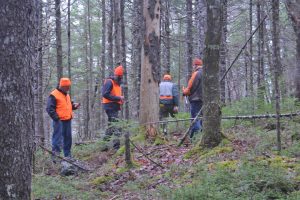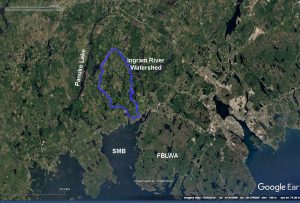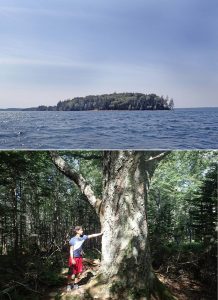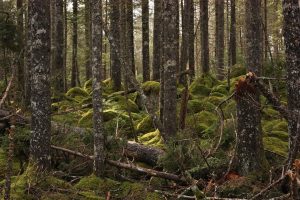Geoff offers four reasons to be optimistic

The Boot (left) ponders the location during a training session in old forest assessment on the St. Margaret’s Bay Bowater-Mersey lands, Nov 24, 2016. Photo by John Himmelman
Click to enlarge
“The Boot” as I like to call Geoff LeBoutilier, has had successes and setbacks in his decades long efforts to foster healthy communities and healthy lands in his beloved St. Margaret’s Bay area, and beyond. He was the driver behind formation of the St. Margaret’s Bay Stewardship Association in 2003, which subsequently campaigned for protection of Micou’s and Troop islands and today sponsors a highly successful Eyes On Islands: St. Margaret’s Bay Island Community Stewardship Program amongst many other activities. Geoff was highly active in the ultimately successful, community based efforts to protect the Five Bridge Lakes Wilderness Area.
When Bowater-Mersey/Resolute pulled up stakes, Geoff spearheaded the Buy Back the Mersey Campaign, which was also ultimately successful, the Dexter government buying the lands on behalf the people of Nova Scotia (and also saving saving the Bowater-Mersey workers’ pension when Resolute was about to walk away).
However efforts to establish a St. Margaret’s Bay Community Forest were rebuffed by government/NSDNR (although the Medway Community Forest proposal, also linked to the Buy Back the Mersey campaign, was accepted). The government also made a secret deal with Northern Pulp giving them access to those lands, and others cut old trees on sensitive lands just east of Panuke Lake . The McNeil government of 2014 in turn spawned a deal with 16 mills (later known as WestFor) that would give them access to all of the western Crown lands, following a script pretty well written by NSDNR.
It all looked rather bleak:
…right here at this very spot, Hubley, NS, the province-wide Buy Back the Mersey movement was born. Thousands of volunteer hours later, the province did just that – they bought back the former Bowater-Mersey lands. We thought we’d won, that all our hard work to ensure that we, Nova Scotians, would finally have a say in the management of our own resource had succeeded. But guess what? We were wrong. The opposite is happening. We are being marginalized, ignored, and opposed at every turn. Our own Department of Natural Resources is licensing harvest on OUR lands, with no transparency, no accountability, and no assurance of good practices. It’s same old same old, only worse. – Geoff Leboutilier quoted in a post on Friends of Nature Society, 2014

SMB=St. Margaret’s Bay, FBLWA=Five Bridge Lakes Wilderness Area. Light patches in Ingram River watershed and environs are mostly clearcuts.
Click on map to view larger version
More water went under the bridge such as the proposed Ingram River Clearcuts in 2014. NSDNR was now beginning to post proposed cuts on Crown land for comment, an outcome of a review of the cutting on sensitive land that had occurred earlier. One response by Geoff and Co. was “diving into the void, the SMBSA and its sister organizations are undertaking their own HCV [High Conservation Value] assessment” (CH, February 16, 2015) . The result: cutting was stopped or modified at several sites. Subseqently SMBSA initiated a campaign to protect the Ingram River Wilderness Area.
There’s more, but flash forward to 2018, and The Boot expresses optimism in an op-ed, OPINION: Community-run forests could generate rural revenue with carbon offsets
(Chronicle Herald, Apr 2, 2018) citing four reasons:
Day after day, we’re pummelled with depressing news about Nova Scotia’s forests….But maybe things are about to change.
We await with great hope, after months of consultation, the report and advice of Professor Bill Lahey, a father of the province’s seminal Environmental Goals and Sustainable Prosperity Act and co-author of the Doelle-Lahey report which, had so much of it not been ignored, might have made sense of net-cage aquaculture.
Another bit of possible good news: About to be renewed, hopefully on greatly improved terms, the Medway Community Forest, licensed as a pilot by DNR three years ago with great fanfare, held up as its poster child, but then starved for territory and force-fed a harvest regime in direct contravention of the organizers’ goal of sound forestry practice.Maybe the lessons learned in the Medway will spawn more and better community forests, the policy’s original intent. The people of St. Margaret’s Bay would certainly support that notion. Who better to manage our forests than the communities that have a long-term stake in their health?
In Halifax, a third positive indicator of better, more enlightened times looms, a brilliant proposal soon to go before regional council for a green network, enhancing connectivity and biodiversity, championing our wild areas, establishing a recreational boon for the city in perpetuity, and branding the city’s identity with a permanent green stamp.
From Protect the Ingram River Wilderness Area (Facebook page)
Perhaps the best news of all, if it can be realized, is carbon offsets for responsible forestry. Private woodlot owners are driving this agenda.
…Up the Indian and Ingram Rivers to Ellershouse, Panuke Lake, and Eagle’s Nest, these lands constitute the western flank of HRM’s brilliant new green network. Its rivers are the Bay’s nutrient pumps, feeding its fishery. Its forests, stewarded for growth and health, could be an invaluable carbon sink to fight climate change, a source of significant revenue to support surrounding Indigenous and non-Indigenous communities through a community forest.
Geoff’s perspective is an inclusive one, he wants the St, Margaret’s Bay lands and beyond to support responsible community based forestry, to provide a diversity of recreation opportunities (including designated ATV routes), and to conserve our precious biodiversity. He urges us to respect our land “according to the Mi’kmaq ethic of netukulimk, stewarded today for seven generations in the future.”
Thanks Geoff, for your indefatigable belief in the inherent good values in our lands and peoples.
———–
The op-ed was republished April 14, 2018 under a different title:
OPINION: A St. Margaret’s Bay call for change in forestry practices
GEOFF LE BOUTILLIER
Published April 14, 2018 – 5:00am


